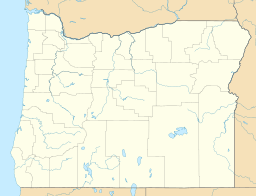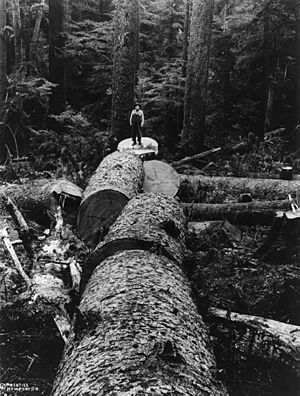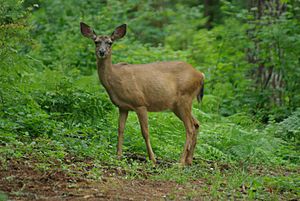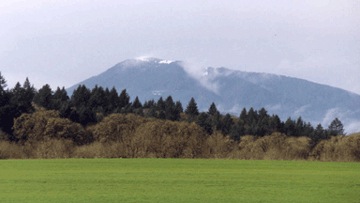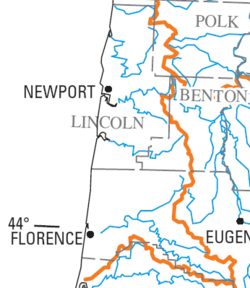Central Oregon Coast Range facts for kids
Quick facts for kids Central Oregon Coast Range |
|
|---|---|

The range from west of Corvallis
|
|
| Highest point | |
| Peak | Marys Peak |
| Elevation | 4,097 ft (1,249 m) |
| Dimensions | |
| Length | 90 mi (140 km) North–South |
| Geography | |
| Country | United States |
| Range coordinates | 44°36′00″N 123°34′00″W / 44.6°N 123.566667°W |
| Parent range | Oregon Coast Range, Pacific Coast Ranges |
| Geology | |
| Age of rock | Paleocene and Eocene |
| Type of rock | volcanic and forearc basin |
The Central Oregon Coast Range is a mountain range in western Oregon, United States. It's the middle part of the larger Oregon Coast Range. This range stretches about 90 miles (145 km) long. Its tallest peak is Marys Peak, which is 4,097 feet (1,226 meters) high. Parts of these mountains are protected within the Siuslaw National Forest and three special wilderness areas: Drift Creek Wilderness, Cummins Creek Wilderness, and Rock Creek Wilderness.
Contents
How the Central Oregon Coast Range Formed
The mountains here are built on igneous rocks from the Siletz River Volcanics. These rocks were formed from hot lava about 50 to 60 million years ago. Scientists believe this lava came from ancient oceanic islands. The rock layer is incredibly thick, up to 16 miles (26 km) deep in some places.
The entire Oregon Coast Range sits where two giant tectonic plates meet. The Juan de Fuca Plate is slowly sliding under the North America plate. This movement, called the Cascadia subduction zone, has pushed the land upwards for millions of years. This process has also created many faults and folds in the mountains.
Shaping the Mountains: Erosion and Weather
Besides plate movements, erosion has played a huge role in shaping these mountains. Heavy rainfall and landslides constantly wear down the land. This creates steep slopes and deep valleys. Unlike many other North American mountains, the Central Oregon Coast Range was not covered by glaciers during the last Ice Age.
Wildlife and Plants of the Coast Range
The Central Oregon Coast Range is a busy home for many creatures. Over 50 types of mammals, 100 kinds of birds, and nearly 30 types of reptiles and amphibians live here.
Birds of the Mountains
You can find many birds in these mountains. Smaller birds include winter wrens, chestnut-backed chickadees, and varied thrushes. Larger birds like pileated woodpeckers, turkey vultures, and red-tailed hawks also live here. Some birds, like the endangered spotted owl and bald eagles, are less common. The American dipper is a unique bird that lives near rivers and builds nests from moss.
Mammals in the Forest
Larger mammals include deer (like black-tailed deer), elk, bobcats, and black bears. Other mammals you might spot are mountain beavers, coyotes, mink, river otters, and raccoons.
Bats are also very common, with eleven different species living in the range. They make up almost 20% of all mammal species here! Some types include the Yuma myotis and the big brown bat.
Amphibians and Fish
The range is home to many amphibians, such as rough-skinned newts and Pacific tree frogs. You might also find snakes like the northwestern garter snake. Rivers in the range are important for fish like chinook salmon, steelhead, and the threatened coho salmon.
Trees and Plants
Most of the range is covered by the Siuslaw National Forest. The main trees are red alder, western hemlock, western cedar, bigleaf maple, and Douglas fir. Other plants include Oregon grape, salmonberry, huckleberry, and sword fern. You can also find many types of grass, sedge, and moss.
Where is the Central Oregon Coast Range?
This mountain range starts near the Salmon River in the north. Oregon Route 18 generally separates it from the Northern Oregon Coast Range. To the south, the Umpqua River and Oregon Route 38 divide it from the Southern Oregon Coast Range.
Weather in the Mountains
The climate here is mild and influenced by the ocean. Summers are cool and dry, while winters are mild and wet. Most of the rain falls in winter. Snow can be found at higher elevations during the colder months. The amount of rain changes from 60 to 120 inches (150–300 cm) each year, with more rain in higher areas. Temperatures also change with elevation.
Tallest Peaks
Here are the tallest mountains in the Central Oregon Coast Range, all over 3,000 feet (914 meters) high:
| Mountain name | Elevation | County | |
|---|---|---|---|
| feet | metres | ||
| Marys Peak | 4,097 | 1,249 | Benton |
| Grass Mountain | 3,563 | 1,086 | Benton |
| Laurel Mountain | 3,553 | 1,083 | Polk |
| Prairie Peak | 3,412 | 1,040 | Benton |
| Saddle Bag Mountain | 3,386 | 1,032 | Lincoln |
| Fanno Peak | 3,317 | 1,011 | Polk |
| Riley Peak | 3,294 | 1,004 | Polk |
| Old Blue Mountain | 3,291 | 1,003 | Benton |
| Prairie Mountain | 3,287 | 1,002 | Benton |
| Bald Mountain | 3,215 | 980 | Polk |
| Condenser Peak | 3,058 | 932 | Polk |
Rivers Flowing from the Range
Many rivers start in the Central Oregon Coast Range. Some flow east towards the Willamette River, and others flow west to the Pacific Ocean.
|
Drains to Willamette River: |
Drains to Pacific Ocean: |
|


